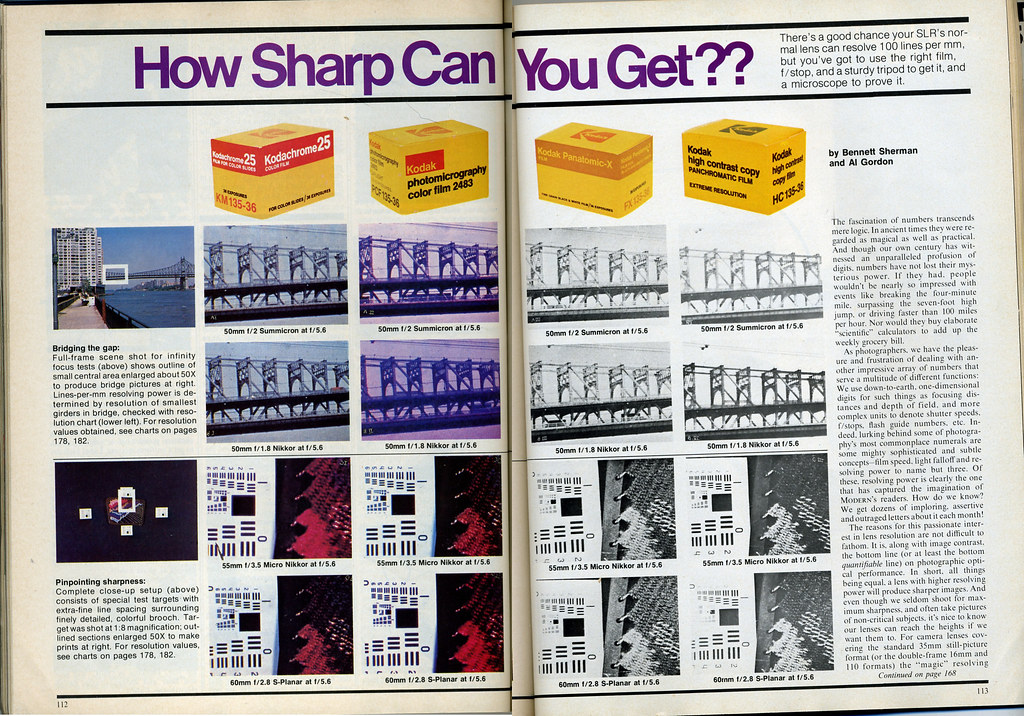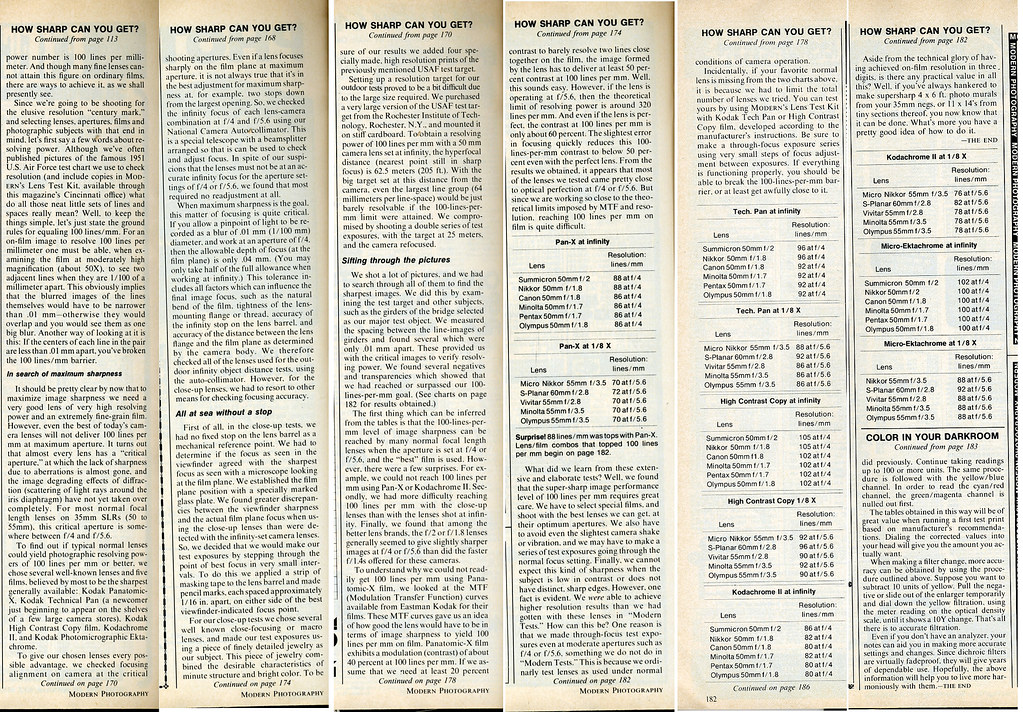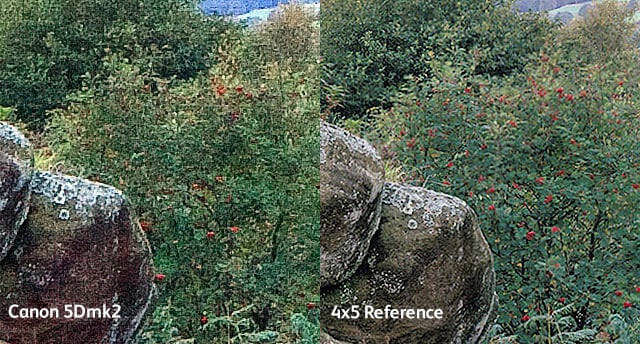|
Forum: Film SLRs and Compact Film Cameras
10-30-2017, 10:45 PM
|
| |
Me too :)
I read this last message and with some time on the DPReview for the D800, I am more clear on your methods and they are close to what I thought you were doing though with a few wrinkles. If I am reading the D800 review correctly, they measured 3200 lph which translates to 133 l/mm vertical for that camera with the Nikkor AF-S 50/1.4 G framed to the 3:2 region of an extended ISO 122233 chart. That is a pixel efficiency of 69% and at 1x magnification would badly underestimate the Tech Pan performance if it approaches or exceeds that of the D800.
This is a bit of a rabbit hole and I don't want to hijack the thread more than already done. I would like to continue further via private message if that is OK. I have some additional questions and an observation or two.
Steve
|
|
Forum: Film SLRs and Compact Film Cameras
10-29-2017, 08:55 PM
|
| |
First off, I want to tell you how much I respect the huge library of photo-associated visuals you have generated and share with the users on this site. I hope you don't take any of the below as criticism.
*********************************
I have puzzled over that graphic more than once over the years* and my interpretation has been that it has:
(Courtesy LINK to full-sized JPF of the graphic)- Four crops of digitized optical copies of a Tech Pan negative, two at 1x (D800 and scanner), one at 0.67x (K20D), and a fourth at 4.5x (also K20D)
- The full image for the first three would have been of the full 24x36 Tech Pan negative. The last (4.5x mag) would have included mostly the area of interest.
- The amount of detail captured for each crop may be ranked in the order 0.67x (K20D) < 1x (D800) < 1x (4000 DPI scanner) < 4.5x (K20D)
- 1:1 mapping of "dots" to pixels assumed for the scanner
- Variables include pixel efficiency for the capture, quality of optical system, and presentation of the negative (lighting, flatness, alignment)
I called out the magnification because it is equivalent to applying a microscope to create the image. The higher the magnification, the more we might see...regardless of whether we do or not.
From the information presented, I would choose the scanner for a full-frame copy over the other methods. I also note that none of those methods captured the full detail of the negative and that it is possible that a magnification other than 4.5x might equal or better that case (e.g. 1.5x or 20x or whatever).
What I am unable to do is infer how much detail was captured on the negative itself. To estimate that I would need the pixel efficiency of the system (optics, image processor, presentation, etc.) so I would have a notion of how much was not "seen". The D800 is a good example in that its rank should have been above the scanner for a 1x full-frame copy based on capture resolution alone. Was there a focus problem? Optical field curvature? Loss due to Bayer interpolation? I dunno.
To be honest, I would not expect any of the systems to fully replicate even a Kodak Gold 200 negative. There is always sampling loss. The same is true for an optical enlargement, a projected image, a contact print, or even direct microscopy.
FWIW, it would have interesting to see if the D800 and the K20D were equivalent at 1x (similar pixel pitch). :)
Steve
* I had seen it before as example in the past on other threads.
|
|
Forum: Film SLRs and Compact Film Cameras
10-29-2017, 04:02 PM
|
| |
Excellent!
I came across an interesting statement from Klaus on what was photozone that they did not test a particular lens on the Sony A7R because the shutter vibration on that camera was so wretched that they could not get good results for lenses that they knew were good. :p
Steve
|
|
Forum: Film SLRs and Compact Film Cameras
10-29-2017, 03:40 PM
|
| |
I found it! Reading from a larger copy at Flickr is easier, so click through on the link and/or the full resolution link I am providing.

How Sharp Can You Get?, p1 by Jussi, on Flickr
Higher Resolution versions of "How Sharp Can You Get?", p1

How Sharp Can You Get - continued by Jussi, on Flickr
Higher Resolution versions of "How Sharp Can You Get?" - continued
The entire article, despite dating to the early 1980s, is pertinent to the technical aspects of this discussion as well as to best-case user expectations. Of particular interest is methodology for determining captured resolution. Note that from a selection of available lenses from the major vendors, the Pentax-M 50/1.7 made the cut over faster offerings. The same was true across the board with nothing faster than f/1.7 in the test. Here are a few of the highlights:- The only color film to deliver 100 l/mm was Micro-Ektachrome
- No emulsion intended for general pictoral photography was able to deliver 100 l/mm with any of the lenses surveyed
- No the Pentax 50/1.7 did not sweep the field; that honor went to the Leitz Summicron 50/2
- No, dedicated macro lenses did not outperform any of the fast 50s, even for close focus
- Focus bracketing was required for all lens/camera combinations
My favorite paragraph runs as follows:
 Quote: Quote: To understand why we could not readily get 100 lines per mm using Panatomic-X film, we looked at the MTF (Modulation Transfer Function) curves available from Eastman Kodak for their films. These MTF curves gave us an idea of how good the lens would have to be in terms of image sharpness to yield 100 lines per mm on film. Panatomic-X film exhibits a modulation (contrast) of about 40 percent at 100 lines per mm. If we assume that we need at least 20 percent contrast to barely resolve two lines close together on the film, the image formed by the lens has to deliver at least 50 percent contrast at 100 lines per mm. Well, this sounds easy. However, if the lens is operating at f/5.6, then the theoretical limit of resolving power is around 320 lines per mm. And even if the lens is perfect, the contrast at 100 lines per mm is only about 60 percent. The slightest error in focusing quickly reduces this 100-lines-per-mm contrast to below 50 percent even with the perfect lens. From the results we obtained, it appears that most of the lenses we tested came pretty close to optical perfection at f/4 or f/5.6. But since we are working so close to the theoretical limits imposed by MTF and resolution, reaching 100 lines per mm on film is quite difficult. (emphasis mine...SB) But wait! There's more!
As noted above, the Summicron 50/2 performed the best in the testing. That same lens (1979 version) has been tested at what used to be photozone{.}de (now opticallimits{.}com) on the Leica M9 (18Mpx FF). The center resolution results...
f/2.8 -- 3096 lw/ph (129 l/mm)
f/4 -- 3265 lw/ph (136 l/mm)
f/5.6 -- 3228 lw/ph (135 l/mm)
The Summicron 50/2 did somewhat better with an 18 Mpx sensor than on 35mm film despite observed focus shift on stop-down. I could not find whether their test method includes focus bracketing.
Now, the bad news...
Nikkor AF-S 50/1.8 G on the 24 Mpx D3x @ f/5.6 -- 3958 lw/ph (165 l/mm)
Canon EF 50/1.8 STM on the 21 Mpx 5DII @ f/5.6 -- 3742 lw/ph (156 l/mm)
Ummm...the Summicron is running a bit behind a couple of recent consumer grade lenses. Granted, both were run against somewhat higher resolution sensors, but still those numbers are sobering.
But...but...but...Those differences in sensor pixel count are important. Consider the theoretical maximum for each:
Leica M9 -- 3472 lw/ph (145 l/mm)
Nikon D3x -- 4032 lw/ph (168 l/mm)
Canon 5DII -- 3744 lw/ph (156 l/mm)
Normalizing to percentage of theoretical maximum, it is quite likely that all three lenses are sensor-limited on the test cameras.
Conclusion?
The value proposition for moderate focal length primes has never been better. For example, the Canon EF 50/1.8 STM also outperformed the Sigma 50/1.4 DG HSM (Art). In addition, while evidence is hard to come by, the rare objective test and numerous example images tend to indicate that many older lenses continue to perform at or near the theoretical limits for the sensors they are paired with.
With zooms, it is somewhat more difficult to make similar claims. Objective tests for zooms released more than about 15 years ago are hard to come by. What's more, it is pretty much established dogma that all but the newest zooms are troublesome junk and not worth shooting with. I would tend to agree except that I have done some decent work recently with the Pentax-A 70-210/4 on the K-3...go figure :p
Steve
|
|
Forum: Film SLRs and Compact Film Cameras
10-28-2017, 04:29 PM
|
| |
Getting down to technical nitty gritty and as a gentle reminder, it is sort of bizarre to express photographic fidelity to detail in terms of some quantity of pixels for a medium where pixels mean...ummmm...nothing. The number of pixels in digital output simply indicates sampling frequency and nothing more. This is immediately obvious when comparing a low powered microscope sampling of a Technical Pan negative with swatch of digital sensor output for the same subject at similar magnification. The analog film contains far more information in the gross sense than what is recorded by available sensors. To put it in less abstract terms, below is a photo originally published by PetaPixel in 2014. On the left is a crop from a 5DII and on the right is a downsampled scan from a Velvia negative of the same subject.

(from: Comparing the Image Quality of Film and Digital)
The question is...Where did the berries go? The two sides have the same number of pixels.
The simple answer is that the 5DII only recorded what its photo sites saw and what survived the Bayer interpolation. To the 5DII, most of the berries never existed (they fell in between the photo sites) and of those it saw, a significant number were simply averaged away. The article goes on to provide other examples where detail is missing or less accurately described but with less obvious cause despite being expressed in the same number of pixels.
Don't get me wrong, I won't suggest that the above indicates any particular superiority of Velvia or any other film, only that PIXELS or even resolution numbers are not the best way to craft a comparison between two disparate mediums where the measurement only applies to one of the pair.
Steve
(...FWIW, my eye doctor tells me my eyes have somewhat higher acuity than most. Does that mean they have more or fewer Megapixels than a Phase One back?)
|
|
Forum: Film SLRs and Compact Film Cameras
10-28-2017, 03:03 PM
|
| |
For those wishing to checkout the published MTF graphs for Technical Pan, the package insert is available for download from the "Wayback Machine".
Wayback Machine: Kodak Technical Publication P-255
Processing in Technidol yielded MTF-50* of 100 cycles/mm which approximates 100 lp/mm l/mm. PF member Nesster has a Modern Photography article from the mid-1980s on his Flickr photostream where attempts were made to extract 100 lp/mm l/mm from lenses (all fast-50s) and films available at that time. IIRC, that number proved illusive. I will see if I can find it and post it here if I do.
Addendum: Certain current emulsions claim much higher resolution than what was available from Technical Pan.
More Addendum: By calculation, the K-1 can only extract about 102 lp/mm l/mm maximum based on horizontal pixel pitch alone. Actual will be somewhat less.
Steve
* One can get much higher numbers at higher contrast, but those are not applicable for typical pictoral use.
|
|
Forum: Film SLRs and Compact Film Cameras
10-28-2017, 02:39 PM
|
| |
Mythbusters did a segment comparing building size murals made from a FF dSLR vs. film SLR (Both high-end Nikon). Both were done using state of the art reprographics appropriate for each medium. The conclusion was that the dSLR was somewhat better for that task. That being said, you make an excellent point. One can go very big if the viewing distance is also large. It all comes down to degrees of arc.
I used to do a bit of work using Technical Pan and it is my opinion that unless one were using excellent technique and the best lenses available, 16"x20" is the largest I would have gone with the kit I had available at the time. Whether the same lenses would do somewhat better on the K-1, is hard to say.
Steve
|
|
Forum: Film SLRs and Compact Film Cameras
10-27-2017, 08:53 AM
|
| |
I agree, though the degree of magnification is closer to that of an 8x or 10x loup (depending on sensor resolution) when compared to 1:1 pixel mapping.
Steve
|
|
Forum: Film SLRs and Compact Film Cameras
10-27-2017, 08:45 AM
|
| |
Thank you for including this last bit. MTF values for most films made in the last 20 years have been published by the manufacturers and real world maximum resolution may be estimated from those numbers, though it is highly unlikely that any photographer will approach those maximums in the field.
Steve
|
|
Forum: Film SLRs and Compact Film Cameras
10-27-2017, 08:38 AM
|
| |
My slides have zero pixels, though they do have a lot of dye clouds. While Kodachrome has fine grain, its ability to capture detail is usually wildly overstated. The Wikipedia article claims 140 Mpx data equivalent! I suspect that means 3x the theoretical resolution of each of the film's three layers as compared to the theoretical resolution of a digital sensor based on interpixel distance.
Of course, that is all a bit of a red herring. The capabilities of a particular film say very little about how well lenses of the same vintage bend light. However, the proof of the pudding is in the eating and evidence is that excellent lenses from years past seem to be blissfully unaware that they are being stressed by having a digital sensor at their rears. Lenses that worked well on film tend to work well on digital. Similarly, lenses that worked well with a 10 Mpx sensor tend to work even better when given breathing room at 24 Mpx (a bit more than the practical limit for scanned 35mm film) or greater resolution.
Does one need an Otus to be happy at 36+ Mpx FF? It depends on what makes one happy.
To boil it down, here is a bullet list of considerations:- Optical engineering (specifically lens design) is not an expanding field. There has been little new knowledge in the last 75 years.
- Advances in materials and computer-aided design have allowed designs to come to market that were impossible in past decades
- The value of modern coatings cannot be overstated
- Zoom lenses have been the primary beneficiary of modern technologies
- Modern lenses have the benefit of much improved manufacturing technique
- Modern lenses are often not very robust despite the benefits of improved manufacturing
- With the possible exception of coatings, the advances in materials, design, and manufacturing do not translate into a universal "newer is better".
- The "target resolution" of a lens designed for a 36 Mpx FF sensor is the same as for a 15 Mpx APS-C sensor
- Corner resolution is highly overrated
That last point is my opinion. For example, what the new D FA* 50/1.4 claims is corner-to-corner sharpness with few, if any optical aberrations and better performance overall than legacy offerings. Cool! Does that mean that the legacy offerings will let one down? I guess that will have to wait until someone wanders into the field with a FA 50/1.4, FA 50/1.7, and the new lens for a head-to-head on the K-1. My guess will be that the FA 50/1.4 will fare poorly, but the FA 50/1.7 somewhat less so.
Steve
|











